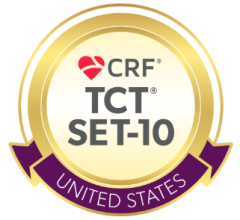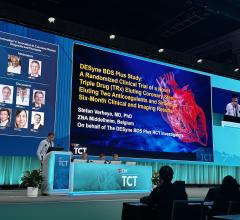
OCT imaging showing before and after images of a heavily calcified coronary artery treated using the Shockwave intravascular lithotripsy system.
November 10, 2021 — Shockwave Medical a pioneer in the development of Intravascular Lithotripsy (IVL) to treat severely calcified cardiovascular disease, today unveiled new data confirming the safety and effectiveness of coronary IVL out to one year, a new gender analysis that found similar outcomes between men and women, and an OCT analysis that found consistent acute performance in eccentric, concentric and nodular calcified lesions. The data from the Disrupt CAD clinical program were presented in several sessions at the 2021 Transcatheter Cardiovascular Therapeutics (TCT) annual scientific symposium of the Cardiovascular Research Foundation (CRF).
First One-Year Outcomes Find Durability of Excellent Procedural Results
The first one-year outcomes from the prospective, multicenter, single-arm, global investigational device exemption (IDE) Disrupt CAD III study demonstrated low rates of major adverse cardiovascular events (MACE, 13.8%) and target lesion failure (11.9%). The MACE results were primarily driven by the rate of non-Q wave myocardial infarction (9.2%), demonstrating durable safety and effectiveness following lesion preparation with IVL prior to stent deployment. The MACE rate included low rates of cardiac death (1.1%), myocardial infarction (10.5%), and target vessel revascularization (6%) one year after the index procedure. In addition, target lesion revascularization (TLR), occurred in only 4.3% of patients and definite or probable stent thrombosis occurred in 1.1% of patients at one year, with only one patient having a definite or probable stent thrombosis beyond 30 days, resulting a late stent thrombosis rate of at 0.3%.
“It is very significant that these data show sustained and persistent relative benefit of IVL for lesion preparation prior to coronary stenting, particularly since this is the first robust one-year report that has been presented on the technology,'' said Dean Kereiakes, M.D., FACC, FSCAI, Medical Director of The Christ Hospital Heart and Vascular Center and the Christ Hospital Research Institute; Professor of Clinical Medicine, The Ohio State University; Co-Principal Investigator of Disrupt CAD III. “The achievement of an average stent expansion of 102% and a minimum stent area (MSA) of 6.5mm2 at the index procedure with IVL should have predicted excellent long-term results. We were optimistic that there should be a low rate of late target lesion revascularization and stent thrombosis to one year, and that is exactly what we found following IVL.”
OCT Analysis Finds Similar MSA and Stent expansion Across Calcium Morphologies
A pooled analysis of 262 patients enrolled in OCT sub-studies from Disrupt CAD I, II, III, & IV, the largest intravascular imaging analysis of any calcium modification tool to date, confirmed that coronary IVL achieved excellent MSA and stent expansion (SE) consistently in lesions with both eccentric and concentric calcium. MSA and SE at the maximum site of calcification were similar across the four calcium arc quartiles analyzed: ≤180° (6.1mm2 & 104%), 181-270° (6.0mm2 & 101%), 271-359° (6.1mm2 & 98%) and 360° (6.2mm2 & 105%), respectively.
In a separate analysis of calcific nodules, coronary IVL was found to have a notable acute effect on calcific nodules, which were identified in 22% of cases, either by flattening or fracturing the nodule, resulting in consistent MSA (6.3mm2 vs 6.0mm2) and SE (101% vs 103%) in lesions with calcified nodules (n=54) or those without (n=194), respectively. The analysis also found that calcific nodules, defined as an accumulation of nodular calcification, or small calcium deposits, with disruption of fibrous cap on the calcified plate, were more commonly associated with concentric calcium and greater overall calcium burden.
“The ability to modify calcium regardless of its morphology, whether eccentric, concentric or nodular, and have MSA and stent expansion still remain consistent shows the versatility of IVL to make a meaningful impact on clinical practice,” said Ziad Ali, M.D., DPhil, director of the DeMatteis Cardiovascular Institute and Investigational Interventional Cardiology at St Francis Hospital & Heart Center, and presenter of the data at TCT. “To date all OCT analyses of IVL reveal that the greater the calcium burden, the greater the number of fractures. These data now show that evidence of visible fracture by OCT is not necessary to achieve large MSA or adequate stent expansion, particularly in these unique, but clinically relevant sub-groups of calcification. The take home message is that IVL liberates vascular compliance in all sub-groups including eccentric lesions and calcified nodules.”
Coronary IVL Found Equally Safe and Effective in Men and Women pooled analysis of the Disrupt CAD I, II, III, & IV studies showed IVL was equally safe and effective in men and women, unlike previous findings with atherectomy.i The analysis of 628 patients stratified outcomes by sex. Women in the analysis, who accounted for 23% of total patients, were older and more likely to have hyperlipidemia, renal insufficiency and prior myocardial infarction. Despite more frequent comorbidities and smaller vessel size in women, the primary safety endpoint of 30-day MACE for women and men was similar (8.3% vs 7.1%, p=0.61). The primary effectiveness endpoint of procedural success for women and men was also similar (91.7% vs 92.6%, p=0.72). Notably, there were also consistent post-IVL serious angiographic complications between women and men (1.6% vs 2.3%, p=0.75), which differs from previous atherectomy gender analyses.
“Given the strong safety profile of IVL and the known higher risks of women undergoing PCI, coronary IVL is an attractive option for optimizing outcomes in female patients,” said Alexandra Lansky, M.D., FACC, FAHA, FSCAI, FESC, professor of medicine (Cardiology); director of Yale Cardiovascular Clinical Research Program Yale University School of Medicine, New Haven, Connecticut
. “While this is the first analysis of its kind for coronary IVL, it is highly suggestive that the technology could potentially serve as first-line therapy for women with calcified lesions, particularly if these findings can be confirmed in a larger patient cohort.”Summarizing the totality of the data presented at TCT, Kereiakes commented, “Looking at these data holistically, it doesn’t matter whether you're in Europe, Japan or the U.S. It doesn’t matter if you're in a big center, or little center. It doesn’t matter which type of calcium or which type of patients you’re treating. The beauty of these data are the consistency of safety and effectiveness. We found no differences with IVL. For these reasons I call IVL the great equalizer.”
For more information: www.shockwavemedical.com
Links to all the TCT 2021 Late-Breaking Clinical Trials
Related Intravascular Lithotripsy Content:
FDA Clears Coronary Intravascular Lithotripsy to Breakup Calcified Lesions With Sound Waves
VIDEO: Intravascular Lithotripsy to Treat Severely Calcified Coronary Artery Lesions — Interview with Dean Kereiakes, M.D.
Intravascular Lithotripsy: Will This New Investigational Technology Crack Calcium’s Code in the U.S.? — Article by DISRUPT CAD III investigators Dean Kereiakes, M.D., and Jonathan Hill, M.D.
FDA Grants Shockwave Medical Breakthrough Status for Coronary Intravascular Lithotripsy
BLOG: Coronary Lithotripsy May Become a Paradigm Shift in the Cath Lab
VIDEO: Example of Coronary Lithotripsy to Break up Calcified Lesion


 October 31, 2025
October 31, 2025 









